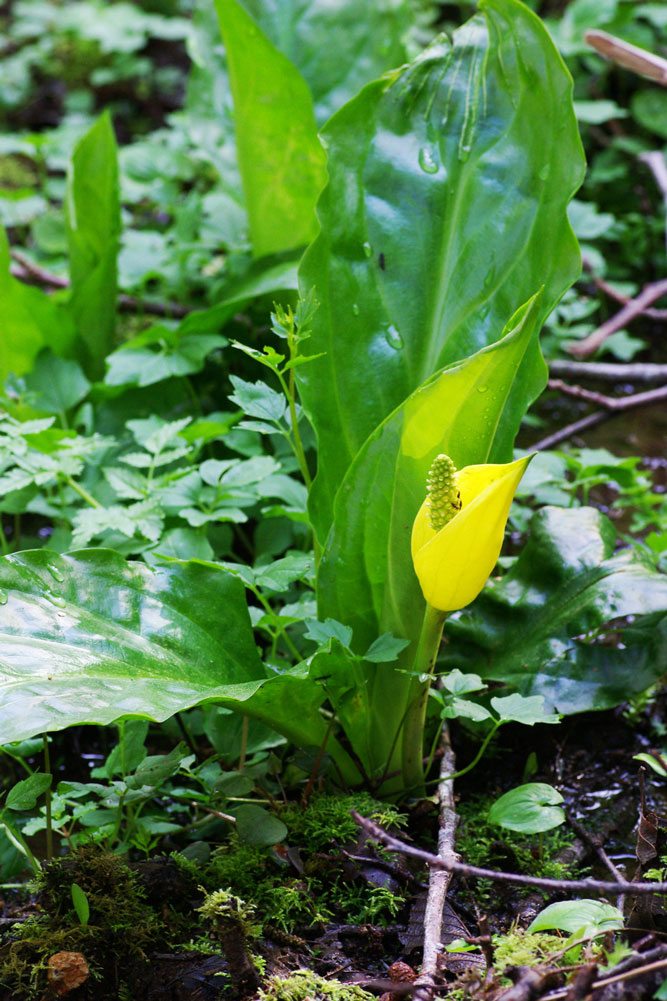Most years the first wildflowers I see are Skunk Cabbages. Despite their name, these are really lovely, showy flowers that provide a splash of bright yellow long before most other wildflowers begin to grow.
Skunk Cabbages are herbaceous perennials, growing from fleshy rhizomes each spring. The name comes from a skunky odor that emanates from the whole plant, not just the blooms. I find the odor distinct, but much less objectionable than you might expect from the name. You should not let it deter you from a close examination of the exquisite blooms. They are abundant along the Oregon Coast, including throughout Tillamook County, growing in damp forests, swampy wetlands, permanent marshes, creek margins, and even in seasonally damp pastures.
Skunk Cabbages are members of the Aroid family, a mostly-tropical group of herbaceous plants with just a scattering of species in North America. The defining feature of most Aroids is the bloom, consisting of a “spadix” variously enclosed, surrounded, or cowled by a “spathe.” These are two pieces of botanists’ jargon that do not readily translate into everyday English. The “spadix” is a fleshy spike covered with tiny, individually inconspicuous flowers. The spathe is a bract or modified leaf that generally wraps around the base of the spadix, and may pretty-well enclose it, or in other species just highlight it.
In the tropics, Aroids include wetland plants, and high-climbing rainforest vines and epiphytes. Temperate-zone species are terrestrial or aquatic herbs. They seem to need moist environments, but otherwise occur in many situations from full sun to deep shade. Numerous tropical species and some temperate eastern hemisphere ones are popular garden or houseplants, among them Philodendrons, Anthuriums, Caladiums, Dieffenbachias, Jack-in-the-Pulpits, and Calla Lilies. Skunk Cabbage is the only “typical” aroid in the Northwest, although botanists have recently concluded that the tiny floating duckweed plants are actually degenerate aroids.
Skunk cabbage blooms have a spadix 2-4 inches long, greenish with tightly packed yellow buds that open to tiny white flowers. The spathe forms a bright yellow cowl covering the spadix, but with a lanceolate opening in one side. As the plant matures both the spathe and spadix expand, but the spadix grows out through the opening and eventually overtops the spathe. Before opening, the spathe is tightly wrapped around the spadix, and after opening, the spathe sometimes retains impressions of the buds as a lattice of dents in its translucent tissue.
Most years I see my first Skunk Cabbage flowers in January, and they can be found in bloom along the coast at least into April. At higher elevations, blooming is delayed – I have seen blooms in the fen on top of Mt. Hebo in late May, and in the Cascades well into June. The timing of blooming on the coast within this long season seems backwards compared to other wildflowers.
Typically, we find the first blooms of a species in south-facing sites, sheltered from the wind and open to spring sun. The first-blooming Skunk Cabbages, in contrast, are typically in forested settings, under stands of alders and other trees, and often with standing water. The open pasture sites tend to bloom last, often not until late March or even April.
Like other early-season wildflowers, Skunk Cabbages depend on a different set of pollinators than late spring and summer wildflowers. When Skunk Cabbages are blooming, most bees, butterflies, moths, and other nectar-loving insects are hibernating, or overwintering as eggs, larvae or pupae.
So, these early-blooming plants have to depend on the insects that are active early, which are species attracted to carrion and manure: food sources that can be available throughout the year. For the Skunk Cabbages, typical pollinators are rove beetles, carrion beetles, carrion flies, and manure flies, and of course the skunky odor is an attractant for them.
Some Skunk Cabbage plants produce flowers before the leaves begin to grow, while others sprout the leaves first. Either way, after blooming, the basal leaves continue to grow, often reaching two to three feet in length, and up to a foot wide. The Skunk Cabbage plants are important spring food for black bears when they first emerge from hibernation, and also for elk.
